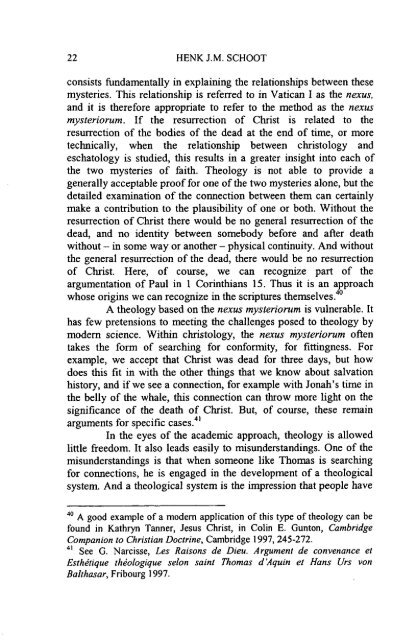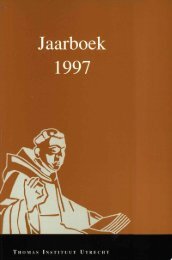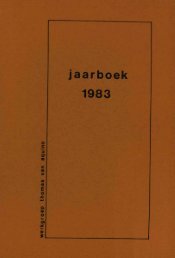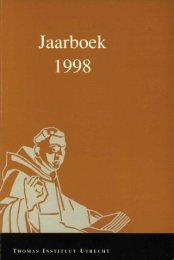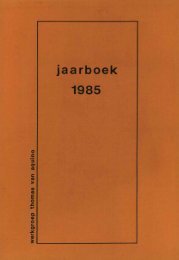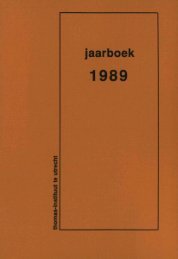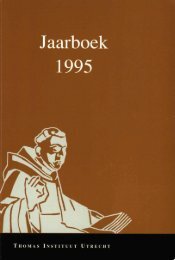Jaarboek Thomas Instituut 2006 - Thomas Instituut te Utrecht
Jaarboek Thomas Instituut 2006 - Thomas Instituut te Utrecht
Jaarboek Thomas Instituut 2006 - Thomas Instituut te Utrecht
Create successful ePaper yourself
Turn your PDF publications into a flip-book with our unique Google optimized e-Paper software.
22 HENK J.M. SCHOOT<br />
consists fundamentally in explaining the relationships between these<br />
mys<strong>te</strong>ries. This relationship is referred to in Vatican I as the nexus,<br />
and it is therefore appropria<strong>te</strong> to refer to the method as the nexus<br />
mys<strong>te</strong>riorum. If the resurrection of Christ is rela<strong>te</strong>d to the<br />
resurrection of the bodies of the dead at the end of time, or more<br />
<strong>te</strong>chnically, when the relationship between christology and<br />
eschatology is studied, this results in a grea<strong>te</strong>r insight into each of<br />
the two mys<strong>te</strong>ries of faith. Theology is not able to provide a<br />
generally acceptable proof for one of the two mys<strong>te</strong>ries alone, but the<br />
detailed examination of the connection between them can certainly<br />
make a contribution to the plausibility of one or both. Without the<br />
resurrection of Christ there would be no general resurrection of the<br />
dead, and no identity between somebody before and af<strong>te</strong>r death<br />
without - in some way or another - physical continuity. And without<br />
the general resurrection of the dead, there would be no resurrection<br />
of Christ. Here, of course, we can recognize part of the<br />
argumentation of Paul in 1 Corinthians 15. Thus it is an approach<br />
whose origins we can recognize in the scriptures themselvea."<br />
A theology based on the nexus mys<strong>te</strong>riorum is vulnerable. It<br />
has few pre<strong>te</strong>nsions to meeting the challenges posed to theology by<br />
modern science. Within christology, the nexus mys<strong>te</strong>riorum of<strong>te</strong>n<br />
takes the form of searching for conformity, for fittingness. For<br />
example, we accept that Christ was dead for three days, but how<br />
does this fit in with the other things that we know about salvation<br />
history, and if we see a connection, for example with Jonah's time in<br />
the belly of the whale, this connection can throw more light on the<br />
significance of the death of Christ. But, of course, these remain<br />
arguments for specific cases."<br />
In the eyes of the academic approach, theology is allowed<br />
little freedom. It also leads easily to misunderstandings. One of the<br />
misunderstandings is that when someone like <strong>Thomas</strong> is searching<br />
for connections, he is engaged in the development of a theological<br />
sys<strong>te</strong>m. And a theological sys<strong>te</strong>m is the impression that people have<br />
40 A good example of a modem application of this type of theology can be<br />
found in Kathryn Tanner, Jesus Christ, in Colin E. Gunton, Cambridge<br />
Companion to Christian Doctrine, Cambridge 1997, 245-272.<br />
41 See G. Narcisse, Les Raisons de Dieu. Argument de convenanee et<br />
Esthétique théologique selon saint <strong>Thomas</strong> d 'Aquin et Hans Urs van<br />
Balthasar, Fribourg 1997.


